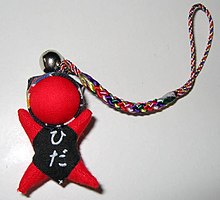Sarubobo
Sarubobo ( Japanese さ る ぼ ぼ or 猿 ぼ ぼ ) is a Japanese traditional rag doll from the Hida region around Takayama, which is known for its craftsmanship .
The doll represents a red toddler without a face, but with a black baby apron. Saru stands for “monkey” ( 猿 ), but can also mean “to keep away dangers and diseases” ( 去 る ), while Bobo refers to a baby in the Hida dialect.
The Sarubobo served as children's toys on the one hand, but on the other hand also served the same purpose as the Amagatsu wooden dolls, which according to the Kōshin folk beliefs adopted from China during the Heian period were intended to protect small children from danger or to divert any dangers onto the doll. In addition, a monkey-shaped doll type is known from the Muromachi period , the shape of which probably goes back to the fact that Kōshin denotes the metal monkey tag. The red of the Sarubobo in turn served as a defense color against the Hōsōgami , a demon who was held responsible for chickenpox .
Today, Sarubobos are popular souvenirs ( omiyage ) from Takayama. While they traditionally had a red color, today they are also sold in other colors that, depending on the color, are said to bring prosperity, health, happiness in love, etc.
literature
- Takako Tokuyama: サ ル ボ ボ の 容 姿 の 変 遷 に 伴 う 縫製 方法 と 赤 い 布 で 作 ら れ た 意味 の 研究 / A Study on the Sense of Sewing Ways with the Change of SARUBOBO'S Red Clothes . In: Gifu Women's University (ed.): Bulletin of Gifu Women's College . No. 31 , 2002, p. 81-88 ( PDF ).
Web links
Individual evidence
- ↑ a b c 猿 ぼ ぼ . In: Daijisen at kotobank.jp. Retrieved August 27, 2015 (Japanese).
- ↑ a b Takako Tokuyama: サ ル ボ ボ の 容 姿 の 変 遷 に 伴 う 縫製 方法 と 赤 い 布 で 作 ら れ た 意味 の 研究 / A Study on the Sense of Sewing Ways with the Change of SARUBOBO'S Red Clothes . In: Gifu Women's University (ed.): Bulletin of Gifu Women's College . No. 31 , 2002, p. 81-88 ( PDF ).
- ↑ a b c Monkey doll brings happiness. In: Satoyama Experience. Chura-boshi, October 5, 2014, accessed August 27, 2015 .
- ↑ Lonely Planet Japan . 2013, p. 500 ( limited preview in Google Book Search).
- ↑ さ る ぼ ぼ の お 店 . Hida Azusa, accessed August 27, 2015 (Japanese).

